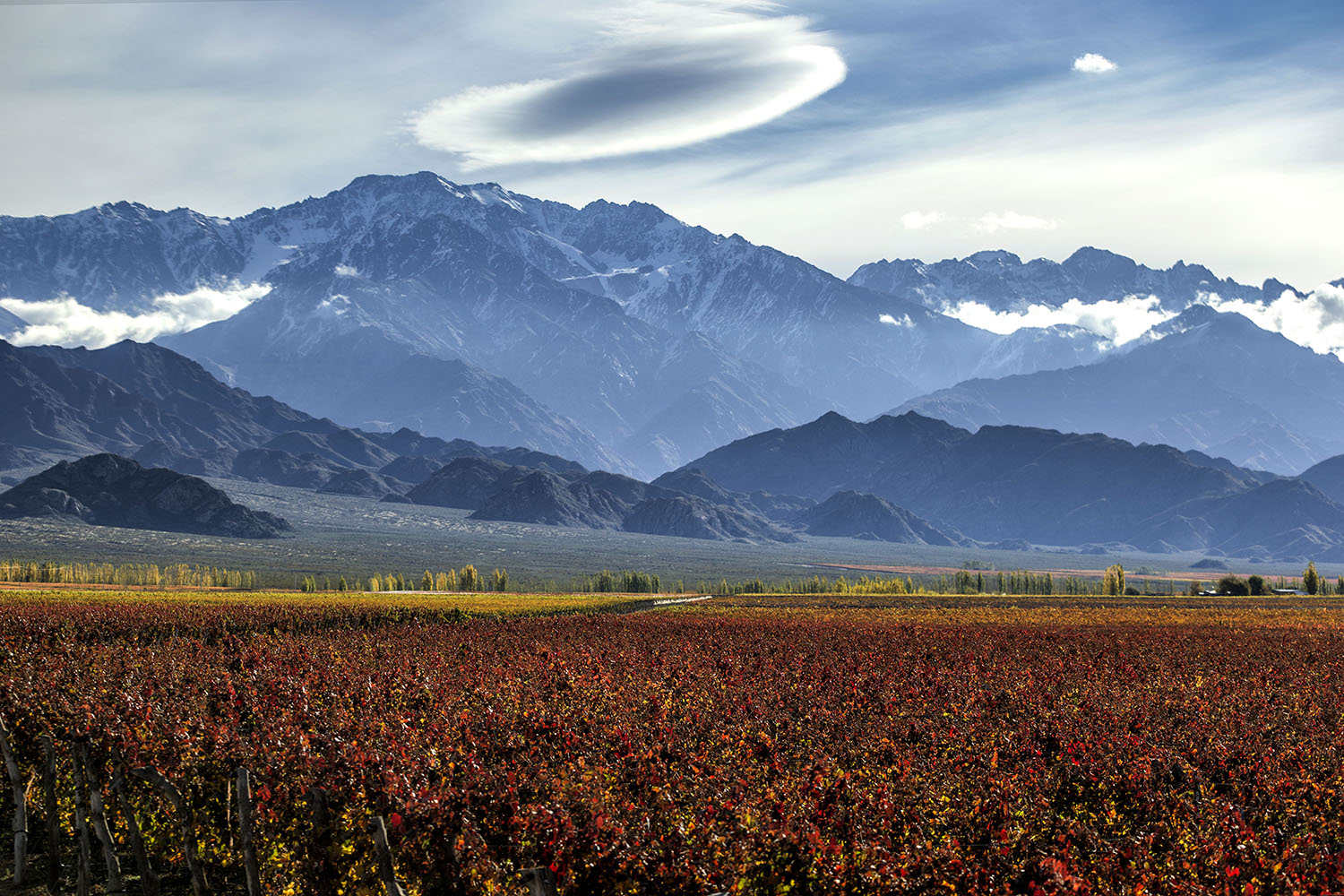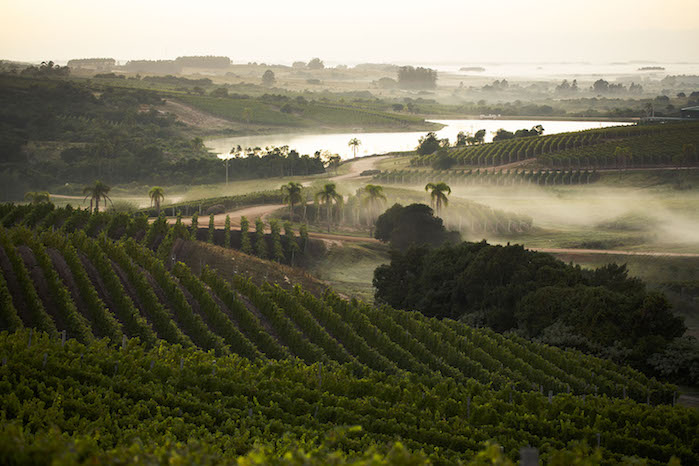Many U.S. wine consumers think of South America primarily as a source of solid, inexpensive wines. In the case of Chile, the wines are probably Cabernet Sauvignon and Sauvignon Blanc; for Argentina, it’s obviously Malbec.
But both countries’ wine industries are undergoing tremendous changes, with an increase in small, quality-minded producers, an emphasis on additional grape varieties and a push into exciting new viticultural areas and additional refinement of the existing ones. Add to that the emergence of wine production in countries such as Uruguay and Brazil, and you have a continent whose wines are poised for a renaissance.
“South America is ready to get hot again – or at least warm,” says Larry Challacombe, president of Global Vineyard Importers, a Berkeley, California-based company that imports only South American wines.
“There’s no better time to be engaged with wine in the region,” adds Julio Robledo, co-owner of Grand Cata, a Washington, D.C.-based retailer that calls itself a “Latin wine shop” (the store sells wines from Spain, Portugal, Italy and the United States, in addition to Latin America).
 Sales numbers indicate that South American wines – specifically those from Chile and Argentina – are having a difficult time breaking out of the budget category. According to Nielsen sales data, average prices for Chilean wines have hovered around $5.75 per bottle for the last five years, while the average price for Argentine wines has seen a modest increase, to $7.40 a bottle (Nielsen mostly tracks sales at supermarkets and other big retailers, which sell a lot of lower-priced Chilean and Argentine wines. The number doesn’t include restaurants or many wine stores).
Sales numbers indicate that South American wines – specifically those from Chile and Argentina – are having a difficult time breaking out of the budget category. According to Nielsen sales data, average prices for Chilean wines have hovered around $5.75 per bottle for the last five years, while the average price for Argentine wines has seen a modest increase, to $7.40 a bottle (Nielsen mostly tracks sales at supermarkets and other big retailers, which sell a lot of lower-priced Chilean and Argentine wines. The number doesn’t include restaurants or many wine stores).
Still, importers, retailers and others knowledgeable on the subject say there are ample opportunities for smaller-production, niche wines – to a point.
Challacombe, for example, says that his sales have generally been up, even in what he describes as a “soft market,” but that it’s challenging to sell South American wines that retail for more than $20. The “sweet spot,” he says, is $12-$19.
Brian Ravitsky, the Brooklyn-based co-owner of Brazos Wine Imports, agrees. While wines that retail for $12 or $15 are strong sellers, demand drops off some for wines over $20. And “it’s really difficult to try to sell South American wine that’s more than $30 retail.”
Argentina
In the wine world, Argentina is synonymous with Malbec.
“The key to our success in the market has been and will be our Malbec,” says Magdalena Pesce, marketing and communications manager for Wines of Argentina in Mendoza. Pesce says the country has “transformed how the world perceives this grape.” (Malbec historically was one of the grapes of Bordeaux, but French plantings now are found primarily in Cahors, an appellation that’s not exactly a household name). Interestingly, however, Malbec accounts for only about 20 percent of the vineyard acreage in Argentina, although it’s the most-planted grape.
“Most wine drinkers now know Malbec and enjoy its fruit-forward (similar to red blends), complex (similar to Cabernet) and soft (similar to Pinot Noir) flavors,” says Laura Catena, managing director of the well-regarded Catena Zapata winery in Mendoza. “Most restaurant lists now include a Malbec, and that is new as of the last few years. It is here to stay.”
But being identified so closely with a single grape variety presents a “quandary,” says Evan Goldstein, a San Francisco Bay Area Master Sommelier and author of “Wines of South America: The Essential Guide.”
“Americans love it,” he says, because it offers flavor, deep color and volume in the mouth, but also soft tannins. But “what is Malbec 2.0?”
“Argentina has done itself a disservice by pumping a lot of inexpensive Malbec into the market,” says renowned California winemaker Paul Hobbs, who has a winery partnership, Viña Cobos, in Argentina and consults in Chile and Uruguay. He likens the situation to Yellowtail, which was phenomenally successful but ultimately cheapened the reputation of Australian wine.
But several of the people interviewed, including Hobbs, pointed out that there’s a next act for Malbec, as a number of vintners change their approach. “After Malbec, what’s next? More Malbec,” Robledo says. “More Malbec, but Malbec with focus.”

That means Malbec with more freshness rather than simply ripe, soft fruit. And it means wines that reflect a more specific terroir – sub-areas like Tupungato or Agrelo, or even single vineyards, instead of the much broader Mendoza designation.
Those smaller areas are “where the game is today,” Hobbs says.
Many of these sorts of Malbecs are made by small wineries, but larger producers like Catena have gotten into the act. In Catena’s case, the winery has a Catena Appellations tier, which, according to Laura Catena, has seen impressive growth.
Outside of Mendoza, the best-known region probably is high-altitude Salta, in the far north, which grows some interesting Malbec but is particularly good for a white grape, Torrontés. But Patagonia, to the south, is an up-and-coming viticultural area, especially for cool-climate grapes like Pinot Noir and Chardonnay.
What about other grape varieties? “While Malbec is still the king, it’s not 100 percent of the game,” Hobbs says. He, Ravitsky and Goldstein all mentioned Cabernet Franc. In fact, Goldstein thinks Cabernet Franc has a bright future in a number of locations in South America.
Goldstein says that Bonarda, the second-most planted red grape, is “capable of being the Zinfandel of Argentina.” Pesce of Wines of Argentina cites an “Argentinean white wine revolution,” which includes old-vine Semillon. There’s also the aforementioned Torrontés, and Hobbs says there’s a small movement toward making “orange” wines.
“The main challenge in the future will be to show the potential of Argentina and its high quality in other varieties, without neglecting the Malbec as our emblem and legacy,” Pesce says.
Chile
If Argentina is closely identified with one grape variety, Chile is just the opposite: The country’s wine industry is remarkably diverse. Cabernet Sauvignon is the most widely distributed Chilean wine in this country, but offerings range from racy, cool-climate Sauvignon Blanc to Carmenere (a red grape that’s rare outside Chile) to such esoteric bottlings as very old-vine País and Carignan.
Top Chilean wines can retail for $100 or more, but most consumers equate Chile with inexpensive wines. “Chile entered the market with cheap and cheerful Cabernet,” says Marybeth Bentwood, executive director for the U.S market for Wines of Chile. But inexpensive wines are losing out in the U.S. market to wines that cost $10 or more (China currently is the No. 1 export market for Chile.)
Wines of Chile is trying to change the perception that the country is all about cheap wine by rolling out a promotion focused on Cabernet Sauvignon priced at $15 and above. Why Cabernet? In addition to Cab’s popularity, Bentwood says, it’s easier to persuade consumers to spend a little more on it.
But Chile’s story certainly doesn’t end with Cabernet. “Anybody who thinks there’s nothing new in Chile doesn’t know what they’re talking about,” Bentwood says. She calls diversity both Chile’s “long-term strength and immediate challenge.”
Goldstein certainly thinks Cabernet can co-exist with other varieties in the Chilean story. “Two kids can play happily in the sandbox at the same time,” he says. For one thing, he sees renewed interest in Carmenere.
Two developments are particularly exciting to the Chile-watchers: old vines and new appellations.
Vintners are working to preserve Chile’s old vines, many of which are in the Maule Valley. Much of the excitement surrounds old-vine Carignan, a variety first cultivated in Chile in the early 1940s. There are also old vines – some more than 100 years old – of País, which was brought to Chile by the Spaniards and widely ripped out in recent decades.
As for appellations, there’s a lot of interest in cooler and more extreme areas. Several people interviewed pointed primarily to the south, specifically the Bio-Bio and Itata valleys. Bio-Bio, in particular, has had success with Chardonnay and Pinot Noir. “Most of the excitement is coming out of the southern part of the country,” Hobbs says, although he also mentioned the Limarí and Elqui valleys in the north and the San Antonio Valley in the far west, near the ocean.
Even in the more established Maipo and Colchagua valleys, there’s been further delineation of the growing areas – the Alto Maipo, for example, which sits in the foothills of the Andes.
Chile is dominated by the huge Concha y Toro Group, which produces everything from entry-level wines to the iconic Don Melchor Cabernet. But as in Argentina, there’s been an upsurge of small producers making the kinds of wines that grab the interest of sommeliers and specialty retailers. “There’s a big audience now for small-production wines from all over the world,” Ravitsky says.
Elsewhere
Wine is produced elsewhere in South America, too, albeit in smaller amounts. Of these countries, the one that’s probably best positioned for success in the U.S., is Uruguay, although Brazil might not be far behind.
Uruguay, like Argentina, is most often associated with one grape variety. The problem for Uruguay is that the grape is the relatively unknown Tannat (nevermind that a lot of Americans can’t find Uruguay on a map or confuse it with Paraguay). “We always say that Uruguay is the land of Tannat,” says Martin López, who is in charge of international promotion for the National Wine Institute of Uruguay. “But sometimes it is like a double enigma. What is Uruguay, and what is Tannat?” So the industry is also trying to stress its diversity. Despite the fact that beef is a dietary mainstay in Uruguay, vintners are making tremendous strides with whites. Grand Cata’s Robledo singled out Albarino as a grape that does well.
For now, though, Tannat is the thing, and it accounts for about 34 percent of the vineyard acreage in Uruguay. Quality is continually improving, as vintners learn how to tame the grape’s notorious astringency. “They’re getting the Tannat, like, world class,” Robledo says.

“The wines we’re seeing are really stunning,” says Hobbs, who consults for the Deicas family at Juanicó.
As in Chile and Argentina, viticulture is also migrating to new areas. Some of these new plantings are the result of foreign investment, as is the case with the impressive Bodega Garzón project, 45 minutes from the resort town of Punta del Este. The estate, owned by an Argentine billionaire, produces excellent Tannat and an outstanding Albarino.
Uruguay’s main obstacle in the U.S. market is that there aren’t many importers bringing in the wines. Still, U.S. imports have, for the most part, been steadily increasing – and prices are up, too, López says.
Brazil’s best bet for the U.S. market is probably sparkling wine. Goldstein thinks that the grape Brazil does best is Merlot, but he says that, given the global interest in sparkling wine, “the lead dog for Brazil will be and should be sparkling wine.”
Robledo concurs about the bubblies. “They are delicious,” he says, adding that Brazilian sparkling wine is the “biggest surprise of them all.”
A Northern California resident, Laurie Daniel has written about wine for more than 20 years. Her wine column appears in several California newspapers, and her articles have appeared in magazines such as Wines & Vines, Food & Wine, Wine Country Living, Drinks and the Wine Enthusiast.









